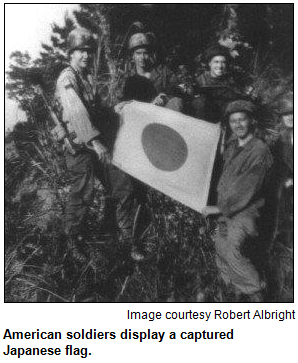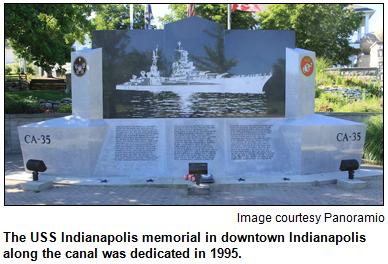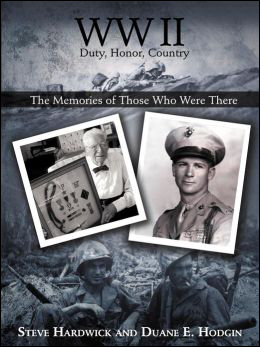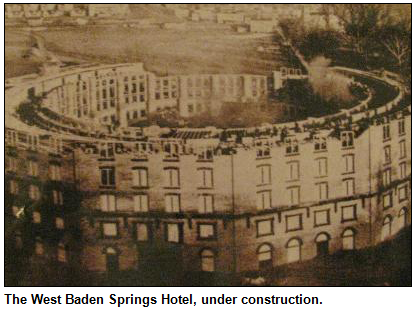Jan. 11 show
World War II veterans remember
Ranging from Marines, sailors and others who survived combat on the front lines to Hoosiers who served on the home front, more than 84 veterans of World War II, all with links to Indiana, have described their personal stories to educators Steve Hardwick and Duane Hodgin.
 Then Steve and Duane, who were colleagues in Lawrence Township Schools in Indianapolis, pulled the remembrances together in a book titled WWII Duty, Honor, Country: The Memories of Those Who Were There (iUniverse, 2013).
Then Steve and Duane, who were colleagues in Lawrence Township Schools in Indianapolis, pulled the remembrances together in a book titled WWII Duty, Honor, Country: The Memories of Those Who Were There (iUniverse, 2013).
Now Steve, a fifth-grade teacher at Indian Creek Elementary School and a U.S. Army veteran, and Duane, who has retired as a school administrator and returned to live in his hometown of Richmond, will be Nelson's guests.
They will be joined by a World War II veteran, Noblesville resident Merrill "Lefty" Huntzinger, who was a staff sergeant in the 2nd Infantry Division.
"Lefty" landed at Omaha Beach a few weeks after D-Day. In the book, he recalls asking his squad leader where they were going. This was his reply: "We're going to hell, and if we are lucky, we will soon land up in heaven."
 Fortunately, "Lefty" survived the global conflict that, as Steve and Duane put it in their introduction, some historians consider to be the "single most significant and influential event of the 20th century."
Fortunately, "Lefty" survived the global conflict that, as Steve and Duane put it in their introduction, some historians consider to be the "single most significant and influential event of the 20th century."
 Among the Hoosiers whose memories are featured in their book is the late Jimmy O'Donnell, a U.S. Navy machinist who survived the sinking of the USS Indianapolis in the Pacific Ocean by a Japanese submarine.
Among the Hoosiers whose memories are featured in their book is the late Jimmy O'Donnell, a U.S. Navy machinist who survived the sinking of the USS Indianapolis in the Pacific Ocean by a Japanese submarine.
The episode often is described as the Navy's "worst tragedy at sea." About 800 of the crew (out of a total of 1,190) survived the sinking by remaining afloat in the dark, oil-covered ocean waters - for awhile. Help did not arrive for nearly five days, though. By then, about half of those sailors had drowned or had been killed by sharks.
In 1995, a monument to the USS Indianapolis was dedicated in downtown Indy. Jimmy O'Donnell, who retired as a firefighter, attended that ceremony; he died last January at age 92.
 Other veterans of WWII whose memories are shared in the book by Steve and Duane include an Indy native who was one of the first group of African-Americans to serve in the Marines, as well as a nurse from Corydon who, like our guest "Lefty," landed at Omaha Beach a few weeks after D-Day. Serving in a trauma unit, she treated soldiers with serious head, chest and abdominal injuries.
Other veterans of WWII whose memories are shared in the book by Steve and Duane include an Indy native who was one of the first group of African-Americans to serve in the Marines, as well as a nurse from Corydon who, like our guest "Lefty," landed at Omaha Beach a few weeks after D-Day. Serving in a trauma unit, she treated soldiers with serious head, chest and abdominal injuries.
As The Indianapolis Star noted in an article about Steve and Duane's book last February, the experiences described by the veterans include "some (that are) funny, some sad, some gut-wrenching and some awe-inspiring."
The book evolved from a history project Steve initiated in 2001 at Indian Creek. A tribute to WWII veterans, the event has become an annual gathering in Lawrence Township and has been attended by many of the 84 veterans profiled in the book.  Of the 84, all are at least 87 years old; about 15 have died since Steve and Duane began their interviews and collecting photos.
Of the 84, all are at least 87 years old; about 15 have died since Steve and Duane began their interviews and collecting photos.
Those whose stories are featured include Eugene Hodgin of Richmond, the father of our guest Duane Hodgin. Duane was born while his father, a tech sergeant with the medical battalion in the 38th Infantry Division, was serving in New Guinea. Eugene did not see his first son until he was 15 months old. While serving his country, he severely injured his back lifting heavy crates of medical supplies.
"I was on my back in a tent for 30 days and could not move," he recalls in the book. Following that ordeal, he contracted a severe case of malaria.
Our guest "Lefty" Huntzinger was assigned to a machine gun squad that was fighting German soldiers. In the book, he shares memories of nightly rotations pulling guard duty.
 "It's a lonely, scary assignment because you're all alone, and you feel that the enemy has you in sight, and you could be shot at any time."
"It's a lonely, scary assignment because you're all alone, and you feel that the enemy has you in sight, and you could be shot at any time."
He also shares memories of crawling out of his foxhole to drag away a dying comrade whose open chest was full of shrapnel. "Lefty" eventually was awarded a Bronze Star for Valor.
Other Hoosier veterans whose stories will be highlighted during our show (and who are featured in the book) include:
- A sergeant from Terre Haute who fought in the Philippines and was awarded two Purple Hearts. He shares a humorous story about a "great doughnut drop" that caused a temporary cease fire between Japanese and American soldiers. The doughnuts were dropped in a river in a New Guinea jungle.
- An Indianapolis woman who describes life on the home front, including the rationing of gasoline and tires, the sale of war bonds and the planting of victory gardens.
- And a medic from Fountain City who helped liberate several concentration camps. During combat, Bob Swift often cleared injured GIs from the battlefield. He recently visited Steve Hardwick's classroom to speak to fifth-graders about his war experiences.
History Mystery
Indiana native Ernie Pyle was the World War II journalist most admired by the American public. He told the soldiers' stories, reporting from the front lines, rotating among the various branches of service as he joined U.S. troops fighting in North Africa, Europe and the Pacific.
In April 1945, as the war was winding down, Ernie Pyle was killed by a Japanese machine gunner when his jeep came under fire. His remains eventually were brought to the United States for burial, but he was not buried in his hometown of Dana in far-western Indiana. Instead, Ernie Pyle's remains were buried in another state.
 Question: What is the state?
Question: What is the state?
The call-in number is (317) 788-3314. Please do not call into the show until you hear Nelson pose the question on the air, and please do not try to win the prize if you have won any other prize on WICR during the last two months.
The prize is a gift certificate to California Pizza Kitchen in Circle Centre Mall, and two tickets to the Rhythm Discovery Center, courtesy of Visit Indy.
By request, we are publishing the answer to the live History Mystery, in case you didn't catch it on the air. The Jan. 4 show History Mystery: To help save a historic county courthouse in Indiana from demolition, several members of a local bridge club came up with a creative - some said quirky - idea to raise funds and public awareness in 2006. The women, most of whom were in their 80s (some were even in their 90s), posed for a calendar - in the buff. In what Indiana county is the courthouse?
Answer: RANDOLPH COUNTY.
Members of a bridge club in the east-central Indiana town of Farmland were appalled in 2006 when they learned that the Italianate courthouse in Randolph County was scheduled to be demolished and replaced by a new building.
Inspired by a movie titled Calendar Girls (2003), the women - most of whom were more than 80 years old - undressed and posed for the Court House Girls Calendar. They stood behind small, porcelain replicas of their beloved courthouse.
Eventually, the vote by county commissioners to demolish the courthouse was overturned. State legislators also credited the calendar girls with prodding the General Assembly to create a preservation commission on Indiana courthouses.
Your Hoosier History Live! team,
Nelson Price, host and creative director
Molly Head, producer, (317) 927-9101
Richard Sullivan, webmaster and tech director
Pam Fraizer, graphic designer
Garry Chilluffo, creative consultant
Michele Goodrich, Jed Duvall, grant consultants
Joan Hostetler, photo historian
Dana Waddell, volunteer-at-large
www.hoosierhistorylive.org




Please tell our sponsors that you appreciate their support: Indiana Historical Society | Lucas Oil | Story Inn | The Fountain Square Theatre Building

 Acknowledgments to Monomedia, Visit Indy, WICR-FM, Fraizer Designs, Heritage Photo & Research Services, Derrick Lowhorn and many other individuals and organizations. We are an independently produced program and are self-supporting through organizational sponsorships and individual contributions. We do not receive any government funding. Visit our website to learn how you can support us financially. Also, see our Twitter feed and our Facebook page for regular updates.
Acknowledgments to Monomedia, Visit Indy, WICR-FM, Fraizer Designs, Heritage Photo & Research Services, Derrick Lowhorn and many other individuals and organizations. We are an independently produced program and are self-supporting through organizational sponsorships and individual contributions. We do not receive any government funding. Visit our website to learn how you can support us financially. Also, see our Twitter feed and our Facebook page for regular updates.
Jan. 18 show
Indiana's most mysterious county?
With a limestone cave beneath the county seat of Paoli, a village underwater, colorful folklore involving the famous French Lick and West Baden Springs Hotels, a "lost" river and some Confederate sympathizers during the Civil War, Orange County in far-southwestern Indiana may be our most mysterious.
We will explore the limestone cave beneath the historic Orange County Courthouse, where one of Nelson's guests has been a court reporter for more than 40 years. She is Orange County native Diane Dillard, a historic preservationist.
Her late husband, Arthur Dillard, a former prosecuting attorney, completed the manuscript for a book about Orange County's colorful heritage, Casinos, Copperheads, Pioneers and Politicians (Hawthorne Publishing, 2012), before his death. In addition to Diane, Nelson's guests will be two historians/authors with their own links to Orange County's heritage.
 They will include Jim Fadely, who is considered the top expert on Thomas Taggart (1856-1929), the Irish immigrant-turned-Indianapolis mayor-turned French Lick hotel owner who brought international attention to the resort and its mineral springs and spas.
They will include Jim Fadely, who is considered the top expert on Thomas Taggart (1856-1929), the Irish immigrant-turned-Indianapolis mayor-turned French Lick hotel owner who brought international attention to the resort and its mineral springs and spas.
Jim, an administrator at University High School, is heading up a campaign to restore the long-neglected Taggart Memorial at Riverside Park in Indianapolis; Indiana Landmarks had placed the limestone monument on its 10 Most Endangered list for a couple of years.
Nelson's guests also will include author Nancy Niblack Baxter of Hawthorne Publishing, who edited Casinos, Copperheads, Pioneers and Politicians. The casinos in the title refer to gambling that, although illegal in the early 1900s, openly flourished during the first heyday of the French Lick hotel and its arch-rival in West Baden.
Owners of the West Baden hotel included a flamboyant entrepreneur, Ed Ballard, who, like Taggart, rose from humble beginnings to become a millionaire. Our guest Jim Fadely will share insights about Ballard, who was shot to death in Hot Springs, Ark., in 1936.
The West Baden hotel, called the "Eighth Wonder of the World" upon its opening in 1902 because of its spectacular atrium and other features, closed as a hotel in the 1930s. After a lavish restoration spearheaded by the late philanthropist Bill Cook and his wife, Gayle, the West Baden Springs Hotel reopened in 2007. The Cooks also oversaw the restoration of the French Lick Springs Hotel.
 Earlier hotels on the French Lick site - including one that may have been a "hotbed of Copperhead activity" - are described in Casinos, Copperheads, Pioneers and Politicians. ("Copperhead" was a term for Southern sympathizers during the Civil War; it derives from copper buttons some wore.)
Earlier hotels on the French Lick site - including one that may have been a "hotbed of Copperhead activity" - are described in Casinos, Copperheads, Pioneers and Politicians. ("Copperhead" was a term for Southern sympathizers during the Civil War; it derives from copper buttons some wore.)
The Copperhead presence is analyzed by Arthur Dillard, a former president of the Orange County Historical Society, who spent years researching folklore about the county.
The mysterious cave underneath a vast section of Paoli, including the impressive courthouse, exists in part because, as his book puts it, "Ice Age glaciers did not touch this region."
In fact, the cave includes a cavern bigger than the courthouse, according to the book.
Diane and Nancy will share insights about that, as well as about Newton Stewart, an Orange County village that thrived during the late 1800s but had been abandoned by the early 1970s. Subsequently, the village was flooded as part of the creation of Patoka Lake.
They also will discuss bygone dry goods and general stores that once thrived in Orange County, as well as such mysterious street and place names as Moonshine Hollow, Grease County Road, Tater Road and Hog's Defeat Creek.
© 2014 Hoosier History Live! All rights reserved.